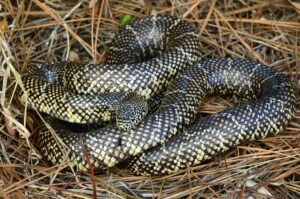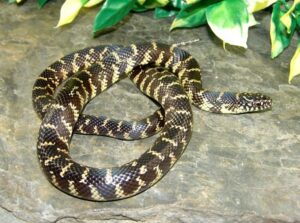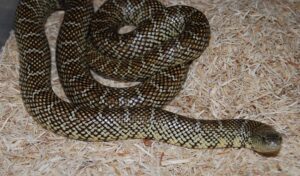Florida Kingsnake (Lampropeltis getula floridana)
Updated on
25/04/2024The Florida kingsnake is a subspecies of the eastern kingsnake that is Florida’s most common kingsnake. As its name implies, the species is endemic to the state. Though they spend most of their time on the ground, the slender-bodied colubrids are reasonably good climbers. They are diurnal though the babies exhibit crepuscular tendencies.
Scientific Classifications
- Suborder:Serpentes
- Family:Colubridae
- Genus:Lampropeltis
- Species:L. getula
- Subspecies:L. g. floridana
Conservation Status
Description
Size
On average, the full-grown serpents attain a size of 3.5-5 ft (106.7-152.4 cm), but 6 ft (182.9 cm) individuals have been recorded.
Color and Appearance
The species has a brown to black base color with yellow-white bands and can have a speckled appearance. The belly is mottled, and the oval head has round pupils. Smooth, glossy scales cover the body and the snake has a black tongue.
Are They Dangerous to Humans
On confrontation, the Florida kingsnake typically flees. It is not aggressive and rarely attacks people. Potential threats are warned by wiggling the tail in dry leaves, mimicking the sound of rattlesnakes. The shy snake avoids contact with people or pets and bites only if people intentionally and constantly bother it.
Florida Kingsnakes at a Glance
Distribution
The species is found throughout central Florida to the southern tip of the state, excluding the keys.
Habitat
It lives in marshes, forests, estuaries, and grasslands. It prefers moist, coastal-type habitats like marshes, swamp edges, and dikes.
Lifespan
The Florida kingsnake lives for 10-15 years.
Predators
The colubrid falls prey to mammals, alligators, and birds of prey. It uses quick, jerky movements, flashing its bands, to startle its predators.
Diet
The opportunistic feeders eat rodents, frogs, bird eggs, lizards, toads, young turtles, turtle eggs, and other snakes (including venomous ones, as it is immune to the poison).
Reproduction
Oviparous (lays eggs that hatch outside the body)
The males fight among themselves to mate with a female. The winner of the fight is the one that gets others to retreat by pinning their heads to the ground. A female lays 3-30 eggs in a clutch. The hatchlings are 5-8 inches (12.7-20.32 cm) in length.
Similar Species
Brook’s Kingsnake
The Brook’s kingsnake (Lampropeltis getula brooksi) can be distinguished from the Florida kingsnake by the thinner cross-bands that are much higher in number. It has more speckling and a paler color (mostly very light yellow).
Care Sheet
The hardiness, docile nature, and beautiful pattern make the Florida kingsnake a popular pet.
Size of the Enclosure: It needs to be kept in a 20-40 gallon aquarium.
Temperature: The temperature of the enclosure should be 84-90°F during the day and 68-75°F at night.
Humidity: The average humidity level of the tank should be 70-80%.
Substrate: Aspen shavings are ideal as the substrate as the pet can burrow in it.
Feeding: The babies can be fed fuzzie or pinkie mice. The size of the food should gradually be increased till the snake becomes an adult when it can be fed large mice.
Source
thebiodude.com, reddit.com, snakemuseum.com, a-zanimals.co.uk, pm1.narvii.com










